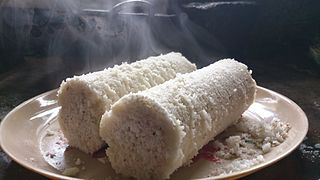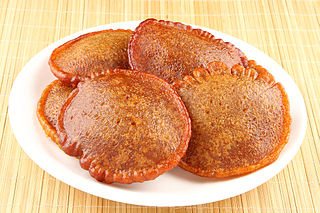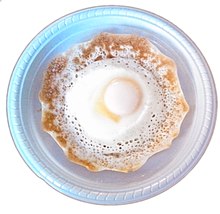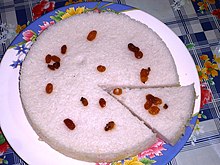
A dosa is a thin, savoury crepe in South Indian cuisine made from a fermented batter of ground white gram and rice. Dosas are served hot, often with chutney and sambar. Dosas are popular in South Asia as well as around the world.

Idli or idly is a type of savoury rice cake, originating from South India, popular as a breakfast food in Southern India and in Sri Lanka. The cakes are made by steaming a batter consisting of fermented black lentils (de-husked) and rice. The fermentation process breaks down the starches so that they are more readily metabolised by the body.

Malay cuisine is the traditional food of the ethnic Malays of Southeast Asia, residing in modern-day Malaysia, Indonesia, Singapore, Brunei, Southern Thailand and the Philippines as well as Cocos Islands, Christmas Island, Sri Lanka and South Africa.

Sambar, known as Kuzhambu in Tamil Nadu, is a lentil-based vegetable stew, cooked with pigeon pea and tamarind broth. It is popular in South Indian, Sri Lankan and Maldivian cuisines. The stew has been adapted into Burmese cuisine as a popular accompaniment to Burmese curries.

Sri Lankan cuisine is known for its particular combinations of herbs, spices, fish, vegetables, rices, and fruits. The cuisine is highly centered around many varieties of rice, as well as coconut which is a ubiquitous plant throughout the country. Seafood also plays a significant role in the cuisine, be it fresh fish or preserved fish. As a country that was a hub in the historic oceanic silk road, contact with foreign traders brought new food items and cultural influences in addition to the local traditions of the country's ethnic groups, all of which have helped shape Sri Lankan cuisine. Influences from Indian, Indonesian and Dutch cuisines are most evident with Sri Lankan cuisine sharing close ties to other neighbouring South and Southeast Asian cuisines.

Tamil cuisine is a culinary style of Tamil people originating in the southern Indian state of Tamil Nadu and neighboring Sri Lanka. Meats, along with rice, legumes, and lentils, are also popular. Dairy products and tamarind are used to provide sour flavors. On special occasions, traditional Tamil dishes are served in a traditional manner, using banana leaves in place of utensils. After eating, the banana leaves are then used as a secondary food for cattle. A typical breakfast meal consists of idli or dosa with chutney. Lunch includes rice, sambar, curd, kuzhambu, and rasam.

Idiyappam, also known as string hopper, indiappa, noolputtu, noolappam, or ottu shavige, is a string hopper dish originating from southern India. It consists of rice flour pressed into noodles, laid into a flat disc-like shape and steamed. The dish also spread to Southeast Asia, where it is called putu mayam in Malaysia and Singapore, and putu mayang in Indonesia.

Puttu is a dish native to the Southern Indian state of Kerala, Tamil Nadu, parts of Karnataka, and Sri Lanka. Puttu means "portioned" in Tamil and Malayalam. It is made of steamed cylinders of ground rice layered with coconut shavings, sometimes with a sweet or savory filling on the inside. Puttu is usually a breakfast dish served hot with either sweet side dishes such as palm sugar or banana, or savoury with chana masala, chutney, rasam, or meat curries.

An uttapam is a type of dosa from South India. Unlike a typical dosa, which is crisp and crepe-like, an uttapam is thicker, with toppings. The name is derived from the Tamil words appam and utthia or uttria, meaning "poured appam", because appam is cooked in a round-bottom pan, whereas utthia-appam is cooked on a flat skillet. Tamil ancient literature mentions it by name. The classic breakfast of Tamil residents consists of idli, dosas or uttappams mostly accompanied by sambar and chutney.

Indian breads are a wide variety of flatbreads and crêpes which are an integral part of Indian cuisine. Their variation reflects the diversity of Indian culture and food habits.

Kue is an Indonesian bite-sized snack or dessert food. Kue is a fairly broad term in Indonesian to describe a wide variety of snacks including cakes, cookies, fritters, pies, scones, and patisserie. Kue are made from a variety of ingredients in various forms; some are steamed, fried or baked. They are popular snacks in Indonesia, which has the largest variety of kue. Because of the countries' historical colonial ties, Koeé (kue) is also popular in the Netherlands.

Neyyappam or Yeriyappa is a sweet rice-based fritter fried in ghee. Neyyappam has its origins in the southern Indian state of Kerala and coastal Karnataka. The name is derived from the words neyy meaning "ghee" and appam meaning "pancake".

Kue putu or putu bambu is an Indonesian kue. It is made of rice flour called suji and coloured green with pandan leaves, filled with palm sugar, steamed in bamboo tubes, and served with desiccated coconut. This traditional bite-sized snack is commonly found in maritime Southeast Asia, particularly in Java, Indonesia, where it is called putu bumbung. Kue putu is usually sold by street vendors and can be found in traditional markets, along with other kues. Kue putu can also be found in the Netherlands due to its colonial ties with Indonesia.

Street food, as in other areas of India, are popular in Chennai, despite the common belief in India that street food is unhealthy. The idly sambhar is a popular dish, which is served as breakfast or dinner. Apart from regular South Indian street food, the city's streets are also filled with several North Indian street food outlets, most of them established by North Indian migrants themselves. Gujarati and Burmese are also available. Street food in Chennai is so popular that a game had developed based on the TV show The Amazing Race where contestants have to follow clues to street-food spots in the city.

Roti jala, roti kirai or roti renjis is a popular Malay and Minangkabau tea time snack served with curry dishes which can be found in Indonesia, Malaysia and Singapore. This is a very traditional Malay dish that is usually homemade and served at events such as weddings and festivals. It is usually eaten in sets of three to four pieces with curries, especially chicken curry, as a substitute to rice.

Kue mangkok or kue mangkuk is an Indonesian kue or traditional snack of steamed cupcake. Kue mangkok means "bowl/cup cake". It is similar to the snack bolu kukus. While both have a similar appearance, bolu kukus requires few ingredients to make, whereas kue mangkok requires more than a dozen in most recipes. The result is a different texure: bolu kukus is soft and fluffy, while kue mangkok has a rough, often chewy and sticky texture.

Indian Indonesian cuisine is characterized by the mixture of Indian cuisine with local Indonesian-style. This cuisine consists of adaptations of authentic dishes from India, as well as original creations inspired by the diverse food culture of Indonesia. Indian influence can be observed in Indonesia as early as the 4th century. Following the spread of Islam to Indonesia and trading, Muslim Indian as well as Arab influences made their way into Indonesian cuisine. Examples include Indian biryani, murtabak, curry and paratha that influenced Acehnese, Minangkabau, Malay, Palembangese, Betawi and Javanese cuisine.




























